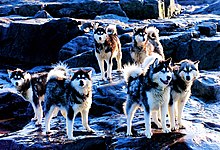This is an old revision of this page, as edited by Pharaoh Hound (talk | contribs) at 00:10, 19 January 2007 (fix image link). The present address (URL) is a permanent link to this revision, which may differ significantly from the current revision.
Revision as of 00:10, 19 January 2007 by Pharaoh Hound (talk | contribs) (fix image link)(diff) ← Previous revision | Latest revision (diff) | Newer revision → (diff) Dog breed| Canadian Eskimo Dog | |
|---|---|
 | |
| Other names | Qimmiq Canadian Inuit Dog |
| Origin | Canada |
| Notes | The UKC does not have an official breed standard |
| Dog (domestic dog) | |
The Canadian Eskimo Dog, otherwise known as the Qimmiq (Inuit for "dog") or what is considered to be the more politically correct Canadian Inuit Dog, is a larger breed of Arctic dog commonly found pulling sleds for their Inuit counterparts. However, as snowmobiles tend to be faster and more efficient, the Canadian Eskimo Dog is now a rare breed.
Appearance
The Canadian Eskimo Dog should always be powerfully built, athletic, and imposing in appearance. It should be of "powerful physique giving the impression that he is not built for speed but rather for hard work" . As is typical of spitz breeds, it has erect, triangular ears, and a heavily feathered tail that is carried over its back. Males should be distinctly more masculine than females, who are finer boned, smaller, and often have a slightly shorter coat.
Coat and colour
The coat is very thick and dense, with a slightly soft undercoat, and stiff, hard guard hairs. It has a mane of fur around its neck, which is smaller in females. They can be almost any colour, except brindle, solid fawn, or only black. White with patches of another colour on the head is the most common colour. Its coat may be pure white, but cannot be albino.
Temperament
The Canadian Eskimo Dog's temperament reflects its original work and environment. It is tough, intelligent, and alert. It is affectionate and gentle, and develops a deep bond with its owner and is intensely loyal. Canadian Eskimo Dogs are best suited as companions for adults, rather than children, as it can be over-excitable. Owing to their original environment, they take pure delight in cold weather, often preferring to sleep outside in cold climates. Like most spitz breeds they can be very vocal.
Care
Canadian Eskimo Dogs need a very large amount of exercise. They cannot just be walked, they need higher intensity work, requiring more exercise than many dog owners can give. This need for work and stimulation also makes them well suited for dog sports, such as carting, mushing, and skijoring. They are very trainable and submissive, unlike many spitz breeds, as well as intelligent. The Canadian Eskimo Dog is best kept in a cold climate, and is prone to heatstroke. Its coat is fairly easy to care for most times of the year, needing brushing only one or two times a week. However when it sheds (which happens once a year) it will need grooming every day.
History

The Canadian Eskimo Dog is generally considered to be a very old dog breed, possibly as old as over 1,000 years. It was first bred by the Thule people. Therefore it is related to the Greenland Dog, so much so that some authorities consider them the same breed. It was, and still is (to a very limited extent), used by the Canadian Inuit as multi-purpose dogs, often put to work hunting seals and other arctic game, and hauling supplies and people.
In the 1800s and early 1900s this breed was in demand for polar expeditions. When snowmobiles came into use the population numbers started rapidly declining, because snowmobiles are faster and need less care. In the 1950s there were approximately 20,000 dogs living in the Canadian Arctic, and had been accepted for showing by both the AKC and CKC, however in 1959 the AKC dropped the breed from its registry because of extremely low numbers. By 1963 there was supposedly only one dog registered with the CKC, and when this dog died there were still no others registered.
It probably would have gone extinct if not for the Eskimo Dog Research Foundation (EDRF). The EDRF was founded in 1972 by William Carpenter and John McGrath and was largely funded by the Canadian Government and the Northwest Territories, with some support from the CKC. The EDRF purchased dogs from the small (about 200 dogs) population remaining in the Canadian arctic from remote Inuit camps on Baffin Island, Boothia Peninsula, and Melville Peninsula. The EDRF then began breeding dogs in order to increase numbers.
The Canadian Eskimo Dog is still very rare, however it is becoming more popular in arctic tourism, with an increasing number of sled dog teams that serve tourists. This newfound popularity is because tourists often enjoy seeing the dogs in their natural environment doing what they are meant for. In 2001 the Canadian Eskimo Dog became the official provincial dog for Nunavut.